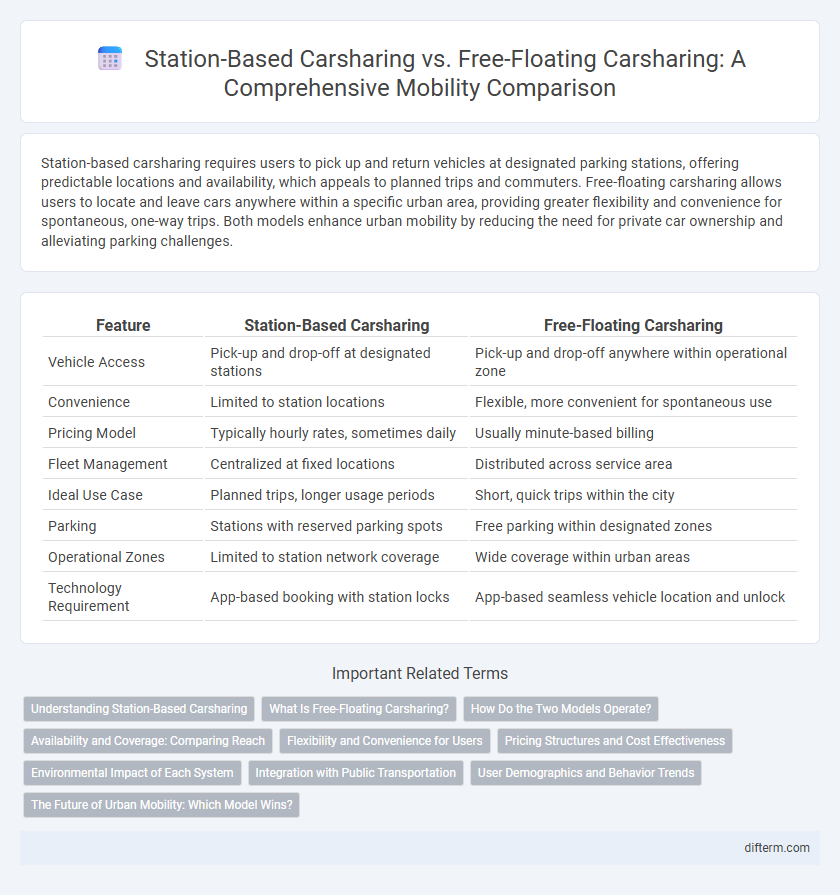Station-based carsharing requires users to pick up and return vehicles at designated parking stations, offering predictable locations and availability, which appeals to planned trips and commuters. Free-floating carsharing allows users to locate and leave cars anywhere within a specific urban area, providing greater flexibility and convenience for spontaneous, one-way trips. Both models enhance urban mobility by reducing the need for private car ownership and alleviating parking challenges.
Table of Comparison
| Feature | Station-Based Carsharing | Free-Floating Carsharing |
|---|---|---|
| Vehicle Access | Pick-up and drop-off at designated stations | Pick-up and drop-off anywhere within operational zone |
| Convenience | Limited to station locations | Flexible, more convenient for spontaneous use |
| Pricing Model | Typically hourly rates, sometimes daily | Usually minute-based billing |
| Fleet Management | Centralized at fixed locations | Distributed across service area |
| Ideal Use Case | Planned trips, longer usage periods | Short, quick trips within the city |
| Parking | Stations with reserved parking spots | Free parking within designated zones |
| Operational Zones | Limited to station network coverage | Wide coverage within urban areas |
| Technology Requirement | App-based booking with station locks | App-based seamless vehicle location and unlock |
Understanding Station-Based Carsharing
Station-based carsharing requires vehicles to be picked up and returned to designated parking spots, enhancing predictability in vehicle availability and parking management. This model supports urban planning by minimizing street congestion and easing the challenge of finding parking in crowded areas. Users benefit from reduced costs due to structured pricing and guaranteed vehicle access at specific locations, improving overall mobility efficiency in cities.
What Is Free-Floating Carsharing?
Free-floating carsharing allows users to pick up and drop off vehicles anywhere within a designated urban area, offering greater flexibility compared to station-based models that require vehicles to be returned to fixed locations. This on-demand mobility solution often integrates with smartphone apps, enabling seamless vehicle reservation, unlocking, and payment. Free-floating carsharing supports short trips and dynamic urban transportation needs, reducing private car ownership and contributing to lower traffic congestion and emissions.
How Do the Two Models Operate?
Station-based carsharing requires users to pick up and return vehicles at designated parking stations within a defined network, ensuring availability and predictability. Free-floating carsharing allows users to locate, unlock, and park cars anywhere within a specified urban area using a mobile app, offering greater flexibility and spontaneous use. Both models rely on digital platforms for reservations, payments, and vehicle tracking but differ in spatial constraints and user freedom.
Availability and Coverage: Comparing Reach
Station-based carsharing offers vehicles at fixed locations, providing reliable availability but limiting coverage to specific areas, typically concentrated in urban centers or designated zones. Free-floating carsharing delivers flexible pick-up and drop-off options throughout a broader area, enhancing coverage and catering to spontaneous travel needs. Evaluating availability and coverage reveals station-based models prioritize consistent access within known hubs, while free-floating systems maximize geographic reach and convenience for diverse mobility demands.
Flexibility and Convenience for Users
Station-based carsharing requires users to pick up and return vehicles to designated parking spots, offering predictability but less flexibility in trip planning. Free-floating carsharing allows users to locate, unlock, and park cars anywhere within a specified zone, maximizing convenience and spontaneity. This on-demand access aligns with urban mobility trends, catering to diverse travel needs without the constraints of fixed stations.
Pricing Structures and Cost Effectiveness
Station-based carsharing typically offers lower hourly rates but charges fees for late returns and requires users to pick up and drop off vehicles at designated locations, making it cost-effective for planned trips. Free-floating carsharing uses dynamic pricing based on demand and charges by the minute or hour without fixed stations, providing flexibility but potentially higher costs for extended use or during peak times. Users seeking predictable expenses benefit from station-based models, while those valuing convenience may accept the variable cost structure of free-floating options.
Environmental Impact of Each System
Station-based carsharing reduces environmental impacts by encouraging vehicle sharing within fixed locations, leading to fewer cars on the road and decreased greenhouse gas emissions. Free-floating carsharing offers greater flexibility, but the increased vehicle circulation and potential for "deadheading" trips can raise carbon footprints and traffic congestion. Life cycle assessments reveal that station-based systems generally deliver a higher environmental benefit per carshare trip compared to free-floating models.
Integration with Public Transportation
Station-based carsharing typically offers designated parking spots near public transit hubs, facilitating seamless multimodal trips and encouraging users to combine carsharing with trains or buses for first- and last-mile connectivity. Free-floating carsharing provides greater flexibility by allowing users to pick up and drop off vehicles anywhere within a defined urban area, enhancing spontaneous mobility but often requiring more careful planning to align with public transportation schedules. Integrating both models with real-time transit data and mobility apps improves overall user experience, promoting sustainable urban mobility by reducing private car reliance.
User Demographics and Behavior Trends
Station-based carsharing users tend to be urban residents aged 25-45 who prioritize planned trips and longer rental durations, often valuing designated parking locations. Free-floating carsharing attracts a more diverse demographic, including younger users aged 18-35, favoring spontaneous, short-distance trips within dense city areas. Behavioral trends indicate station-based users show higher loyalty and subscription rates, while free-floating users exhibit greater flexibility and occasional usage patterns.
The Future of Urban Mobility: Which Model Wins?
Station-based carsharing offers structured access with designated pickup and drop-off points, promoting organized urban parking and reducing congestion in densely populated areas. Free-floating carsharing provides flexible, on-demand vehicle use across city zones, catering to spontaneous trips and supporting dynamic mobility patterns. Innovations in digital platforms and integration with public transit systems are likely to shape the future dominance of either model, balancing convenience, sustainability, and urban space optimization.
Station-based carsharing vs Free-floating carsharing Infographic

 difterm.com
difterm.com